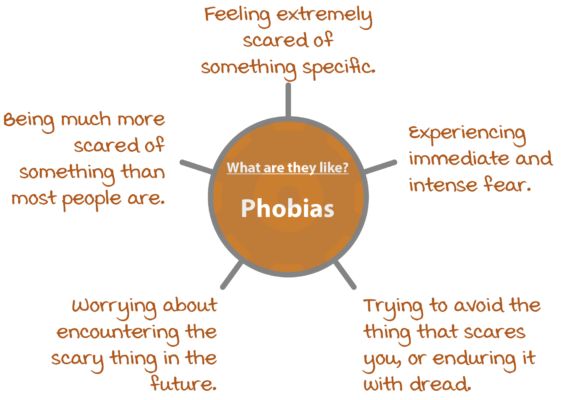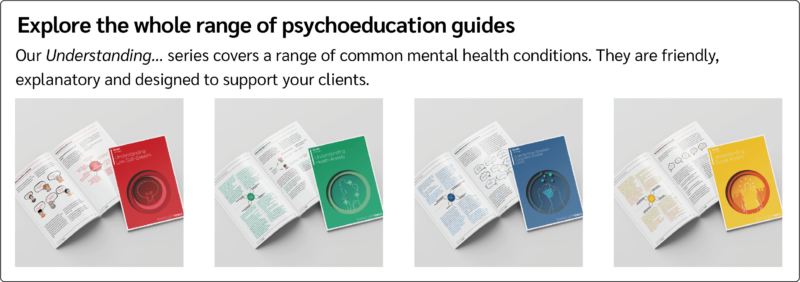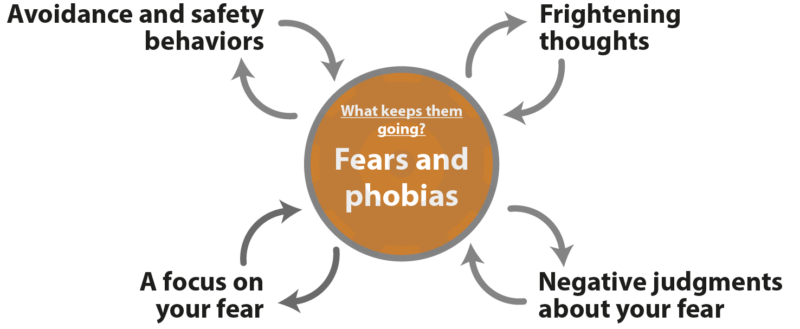Fears and Phobias
Everyone feels afraid sometimes. Uncomfortable as it is, fear is an unavoidable part of life. In fact, a little fear can help you stay safe and avoid danger.
However, fear can become so intense, or trouble you so often, that it leads to serious problems. When specific objects, animals, or situations cause intense feelings of fear that are out of proportion to the actual danger, psychologists call it a ‘phobia’. Research indicates that between 3% and 15% of people will develop a phobia at some point in their lives [1]. The good news is that cognitive behavioral therapy (CBT) is an effective psychological treatment for overcoming fears and phobias.
What are phobias?
Psychologists use the term ‘phobia’ to describe an intense feeling of fear that gets triggered by specific objects or situations, and where the fear is out of proportion to the actual amount of danger. Unfortunately, these extreme fears tend to last a long time and can sometimes lead to other problems with anxiety and depression [1].
People can develop a phobia of almost anything. The most common types of phobias involve:
- Fears related to the environment (e.g., fear of heights, fear of storms).
- Fears related to animals or insects (e.g., fear of spiders or dogs).
- Fear of particular situations (e.g., fear of the dentist, fear of driving).
- Body-based phobias (e.g., fear of injections, fear of childbirth).
Symptoms of a phobia include:

What is it like to struggle with a phobia?
Anyone can develop a phobia. Sometimes they start suddenly, sometimes they develop over time, and sometimes people have a phobia of multiple things. Living with a phobia can have a big impact on your relationships, work, day-to-day activities, and well-being.
Grace developed a fear of spiders
I’ve become really scared of spiders over the last few years. People sometimes ask me why, but I honestly don’t know what caused it. Nothing traumatic has ever happened to me. The only thing I can recall is watching a horror film about spiders when I was little, but it didn’t frighten me that much. I also remember my mom being hysterical if she ever found one in the house. Maybe her fear has slowly rubbed off on me.
As time went on, my reaction to spiders seemed more and more like my mother’s. Whenever I saw one, my heart started racing and I would feel overwhelmed with terror. I’d often scream and run away. Small bits of fluff could sometimes startle me too. It’s like my mind was constantly looking out for spiders.
There were certain things I did to try to manage my fear. I checked the bed for spiders every night, and I always looked inside my shoes before I put them on. There are countries I wanted to visit, but I didn’t because I knew there were venomous spiders there. Whenever I found a spider, I had to leave the room immediately and ask someone to remove it for me. I just couldn’t bear to look at them or go near them. Even toy spiders gave me the creeps.
I knew my fear was out of proportion. It’s unlikely that a spider will ever hurt me, but my instincts seemed to take over. It felt so out of my control, and I doubted that I would ever overcome it.
Do I have a phobia?
If you think you might struggle with a phobia or an intense fear (or if other people think you do) it could be helpful to speak to a mental health professional.
Answering the questions below can give you an idea of whether it is worth arranging a professional assessment.
| Choose the item below that makes you most anxious: | ||||
| Animals or insects | Heights, storms, or water | Driving, flying, tunnels, bridges, or enclosed spaces | Blood, needles, or medical procedures | Choking or vomiting |
| Do you experience moments of sudden terror, fear, or fright when you encounter these situations? | Yes | No |
| Do you experience intense physical sensations when you encounter the thing you fear (e.g., racing heart, trembling, sweating, or rapid breathing)? | Yes | No |
| Does your fear seem extreme compared to how other people react? | Yes | No |
| Do other people think the things you fear are not particularly dangerous? | Yes | No |
| Are there things you won’t do or places you won’t go because of your fear? | Yes | No |
| Do you try to avoid the things that scare you, even if is inconvenient? | Yes | No |
| Does your fear make you want to leave or escape certain situations? | Yes | No |
| Do you think something awful will happen when you encounter the thing you fear? | Yes | No |
| If you can’t avoid what scares you, are there things you need to help you to cope with these situations (e.g., alcohol, medications, superstitious objects, other people)? | Yes | No |
| Do you distract yourself from thoughts about the things that scare you? | Yes | No |
| Are you often on the ‘look out’ for the things you fear? | Yes | No |
| Do you worry about encountering the things you fear at some point in the future? | Yes | No |
If you answered ‘yes’ to most of these questions, you might be struggling with a phobia.You might find it helpful to speak to your general practitioner or a mental health professional about what you are experiencing.
What causes extreme fears and phobias?
Phobias do not have a single cause, but some things can contribute to developing one:
- Evolution. Some psychologists believe humans are pre-programmed to fear certain things. For example, people might be ‘prepared’ to develop a fear of snakes (despite never encountering one) because they were a danger to our distant ancestors [2].
- Your direct experiences. The experiences you’ve had in life can contribute to a phobia [3]. For instance, if you suffered from a nasty stomach bug as a child, you might develop a fear of germs or of vomiting as an adult. However, not all difficult life experiences lead to phobias, and not all phobias are linked to past traumatic experiences [4].
- Your observations. We can learn to be afraid by watching other people [5]. For example, watching a documentary about a plane crash might make you fearful of flying, and having a parent with a phobia can make you more likely to develop a similar fear.
- What you are told. Other people or mass media sometimes communicate (directly or indirectly) that something should be feared [6]. For example, your parents might have told you that certain animals or situations are hazardous and should be avoided.
- Your personality. Some personality traits are more common among people who develop phobias. For example, if you are the type of person who tends to feel anxious or prefer familiar things over new experiences, you might be more likely to develop a phobia [7].
- Your genes. Research indicates that anxiety-related difficulties can also run in families [8]. This doesn’t mean that people are born with phobias, but that genetics might make you more vulnerable to developing problems with fear during your lifetime. However, your experiences in life are likely to play a bigger role.
What keeps phobias going?
Research studies have shown that cognitive behavior therapy (CBT) is one of the most effective treatments for overcoming phobias and extreme fears (Hofmann & Smits, 2008). CBT therapists work a bit like firefighters: while a fire is burning, they’re not so interested in what started it, but in what is keeping it going and what they can do to put it out. If they can work out what is maintaining a problem, they can address it by interrupting the cycles that fuel it.
CBT suggests that there are four things that often keep phobias and extreme fear going. They are:
Treatments for fears and phobias
Psychological treatments for phobias
The psychological treatment for phobias with the strongest research support is cognitive behavioral therapy (CBT) [9, 10]. CBT for phobias usually incorporates exposure therapy, and you might be offered multiple sessions or one extended session, as research suggests that both approaches can be effective [11, 12]. You should seek a therapist with specialist training and experience in treating phobias.
CBT is a popular form of talking therapy. Unlike some other therapies, it is often quite structured. After talking things through with your therapist so they can understand your difficulties, they will set goals with you so you both know what you are working towards. At the start of each session, you will agree an agenda together so you know what that meeting will concentrate on.
Some of the ‘ingredients’ of effective CBT for fears and phobias include [13-15]:
- Developing a shared understanding of what keeps your phobia going, which might be drawn out as a diagram or ‘formulation’.
- Learning about what contributes to your phobia (e.g., avoidance and using safety behaviors).
- Making a list of the situations and activities that trigger your fear (i.e., developing a ‘fear ladder’ or ‘exposure hierarchy’).
- Observing your therapist interact with the thing that scares you (i.e., modeling the process of exposure).
- Interacting with the thing that scares you for an extended period so you can learn that it isn’t dangerous (i.e., in vivo exposure).
- Imagining yourself interacting with the thing that scares you (i.e., imaginal exposure).
- Testing out whether your worst fears come true when you expose yourself to the thing that scares you (i.e., participating in ‘behavioral experiments’).
- Agreeing not to use the coping strategies that have kept your fear going (i.e., dropping your safety behaviors).
- Re-evaluating the fear-inducing thoughts that contribute to your phobia (i.e., cognitive restructuring).
- Making sure that your fears don’t return in the future (i.e., relapse prevention).
Medical treatments for phobia
Medical treatments such as medication are not recommended for the treatment of phobias.
References
- Eaton, W. W., Bienvenu, O. J., & Miloyan, B. (2018). Specific phobias. The Lancet Psychiatry, 5, 678-686. DOI: 10.1016/S2215-0366(18)30169-X.
- Seligman, M. E. P (1971). Phobias and preparedness. Behavior Therapy, 2, 307-320. DOI: https://doi. org/10.1016/S0005-7894(71)80064-3.
- Öst, L. G. (1991). Acquisition of blood and injection phobia and anxiety response patterns in clinical patients. Behaviour research and therapy, 29, 323-332. DOI: 10.1016/0005-7967(91)90067-D.
- Menzies, R. G., & Clarke, J. C. (1995). The etiology of acrophobia and its relationship to severity and individual response patterns. Behaviour Research and Therapy, 33, 795-803. DOI: 10.1016/0005-7967(95)00023-Q.
- Olsson, A., & Phelps, E. A. (2007). Social learning of fear. Nature Neuroscience, 10, 1095-1102. DOI: 10.1038/ nn1968.
- Öst, L. G., & Hugdahl, K. (1981). Acquisition of phobias and anxiety response patterns in clinical patients. Behaviour Research and Therapy, 19, 439-447. DOI: 10.1016/0005-7967(81)90134-0.
- Ashton, M. C., Lee, K., Visser, B. A., & Pozzebon, J. A. (2008). Phobic tendency within the Five-Factor and HEXACO models of personality structure. Journal of Research in Personality, 42, 734-746. DOI: 10.1016/j. jrp.2007.10.001.
- Hettema, J. M., Neale, M. C., & Kendler, K. S. (2001). A review and meta-analysis of the genetic epidemiology of anxiety disorders. American journal of Psychiatry, 158, 1568-1578. DOI: 10.1176/appi.ajp.158.10.1568.
- Hofmann, S. G., & Smits, J. A. J. (2008). Cognitive-behavioral therapy for adult anxiety disorders: A meta- analysis of randomized placebo-controlled trials. Journal of Clinical Psychology, 69, 621– 632. Doi: 10.4088/ JCP.v69n0415.
- Van Dis, E. A., Van Veen, S. C., Hagenaars, M. A., Batelaan, N. M., Bockting, C. L., Van Den Heuvel, R. M., Cuipers, P., & Engelhard, I. M. (2020). Long-term outcomes of cognitive behavioral therapy for anxiety- related disorders: a systematic review and meta-analysis. JAMA Psychiatry, 77, 265-273. DOI: 10.1001/ jamapsychiatry.2019.3986.
- Wolitzky-Taylor, K. B., Horowitz, J. D., Powers, M. B., & Telch, M. J. (2008). Psychological approaches in the treatment of specific phobias: A meta-analysis. Clinical Psychology Review, 28, 1021-1037. DOI: 10.1016/j. cpr.2008.02.007.
- Odgers, K., Kershaw, K. A., Li, S. H., & Graham, B. M. (2022). The relative efficacy and efficiency of single-and multi-session exposure therapies for specific phobia: A meta-analysis. Behaviour Research and Therapy, 159, 104203. DOI: 10.1016/j.brat.2022.104203.
- Choy, Y., Fyer, A. J., & Lipsitz, J. D. (2007). Treatment of specific phobia in adults. Clinical Psychology Review, 27, 266-286. DOI: 10.1016/j.cpr.2006.10.002.
- Tolin, D. (2012). Face your fears: A proven plan to beat anxiety, panic, phobias, and obsessions. John Wiley and Sons.
- Zlomke, K., & Davis III, T. E. (2008). One-session treatment of specific phobias: A detailed description and review of treatment efficacy. Behavior Therapy, 39, 207-223. DOI: 10.1016/j.beth.2007.07.003.
About this article
This article was written by Dr Matt Pugh and reviewed by Dr Matthew Whalley, both clinical psychologists. It was last reviewed on 2023/16/08.



